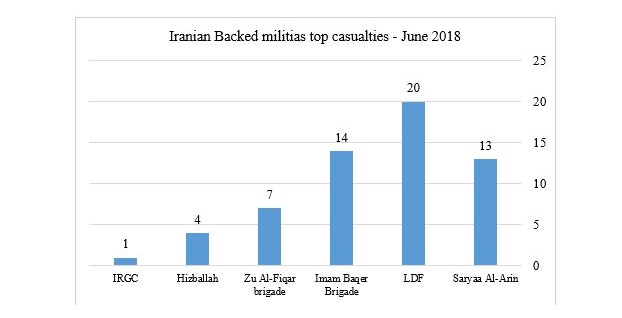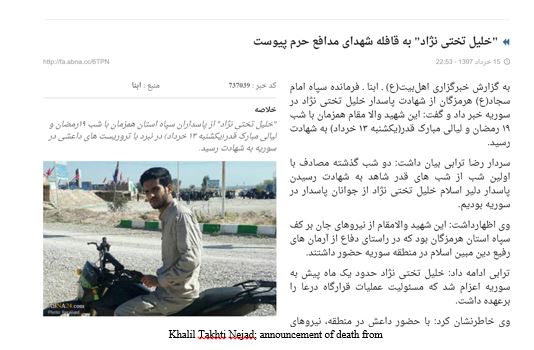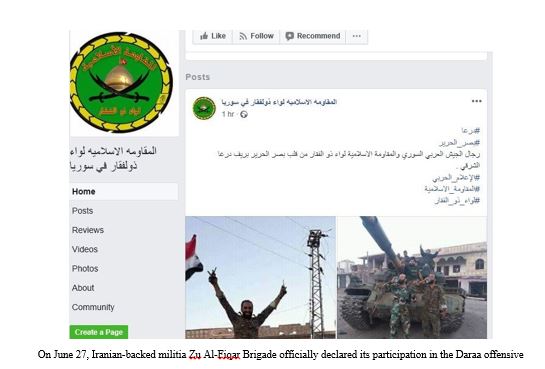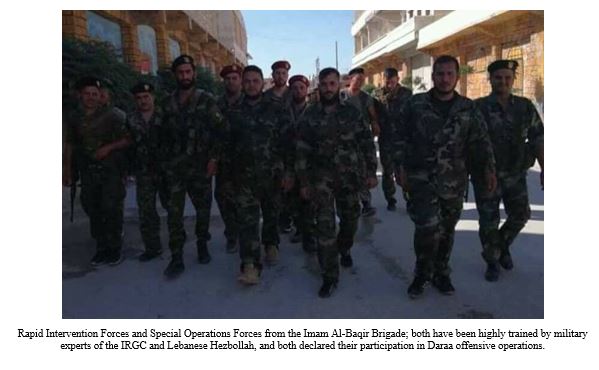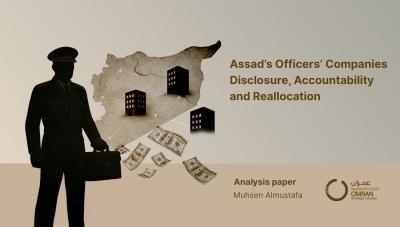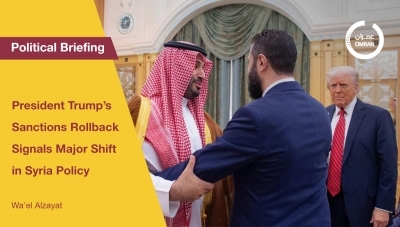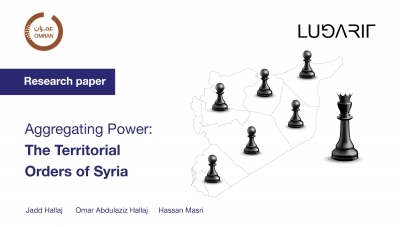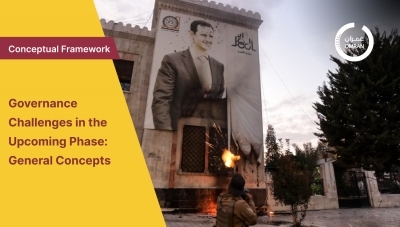Media Appearance
Iranian Involvement in Syria’s Southern Front
This report presents a brief account of latest developments in southern Syria, covering the Daraa and Qunaitera fronts with a specific focus on Iranian involvement from late May until July 17. Prior to the latest escalation along the southern border of Syria, there were reports of an initial agreement between Israel and Russia to push back Iranian and Iranian-backed forces along Syria’s border with Israel. The Iranians reacted by incorporating many of its militias and forces into the Syrian army to continue fighting in the area. Photographs and videos posted on pro-regime media as well as accounts belonging to some of the Iranian-backed militias confirm their involvement. In the final agreement between opposition forces and Russia involving parts of Eastern Daraa and Daraa city, green buses headed to the area to prepare the transportation of a small number of the opposition members to Idlib, while other areas concluded reconciliation agreements. Other areas to the west of Daraa are still going through negotiations to finalize the terms of their agreements. The Russians are pushing for an agreement where minimum number of residents are displaced to Idlib, as a deal to receive them was not concluded with Turkey. At the same time, Iranian forces are pushing for the escalation of attacks to take full control of all southern regions.
Background
In late May 2018, Israel and Russia agreed that Iranian and Iranian-backed forces would vacate areas in southwestern Syria near the Israeli border([1]). Russian President Vladimir Putin stated that due to the Syrian army’s recent advances, foreign forces should withdraw from Syria and mentioned Turkish, American, Iranian and Hezbollah soldiers specifically when asked to clarify. Iranian Foreign Ministry representative Bahram Qassemi responded that Iran would remain in Syria while terrorism exists and for as long as the Syrian government wants Iranian forces there([2]). Nevertheless, in order to reduce pressure from Israel, Iranian-backed forces – including some of Hezbollah members – withdrew from areas in southern Syria only to return as integrated units within the Syrian Army structure. Examples of Iranian-backed forces within the Army include the following:
- 313th Brigade: This brigade is stationed at the Cultural Center in the city of Azra. Brigade fighters withdrew from the city of Daraa in the first week of June and went back to their main base in Sa'Sa.
- Quneitra Hawks: This force is comprised of 200 fighters and was affiliated with Lebanese Hezbollah. It was initially de-mobilized in Khan Arnabeh and then immediately regrouped and joined the 7th Division of the Syrian Army.
- Iranian-backed militias are now stationed in the hills surrounding the towns of Tel Musabah, Tel Arabad, Tel Marz, Tel Ghassem and Tel Ghashim, before they were divided into three units and re-deployed.
- A group of Lebanese Hezbollah fighters were deployed to the town of Khan Arnebeh as part of the 5th Division.
- Al Ghith Forces: This force is affiliated with the 4th Division and was deployed in Khdir Village, on the west side of Majdal Shams.
- Abu al-Fadl al-Abbas Brigade: This brigade withdrew from Eastern Ghouta and moved towards Damascus, only to return after a few days. It is now stationed at Khan Aranbeh and Al-Baath City in Quneitra, at the base of the 10th Brigade in Qantara. Information Unit Sources confirmed the existence of a training camp for the fighters of Abu al-Fadl al-Abbas in Qalmoun, which includes Afghan and Pakistani fighters. The objective of the camp is to send them to the southern front until the Syrian government prepares new identity cards for these fighters as Syrian citizens.
In early June, Russia began deploying troops near territories occupied by Israel, indicating Moscow’s preference for decreased Iranian presence in Syria and despite the dominant presence of Hezbollah in the area. Sources confirmed that Hezbollah was not happy with Russian moves and would demand Russian withdrawal, similar to what happened in Al-Qusir, Homs in the first week of June. Conveying Iranian opinion, Brig. Gen. Masoud Jazayeri told Lebanon’s al-Manar, “Iran and Syria enjoy deep relations that would not be influenced by the propaganda measures of anyone,” adding also that Lebanese militias would not leave Syria([3]).
Attack Stage
The following is a list of top Iranian-backed militias and forces involved in the escalation of violence in the southern front:
| Militia Name | Origin | Situation in Syria |
| Imam al Baqir Brigade | Syria | Part of LDF |
| Lebanese Hezbollah | Lebanon | Special Forces |
| Saryaa Al-Arin | Syria | Military Security Branch |
| Zu Al-Fiqar Brigade | Iraq | Republican Guard |
| Imam Hussein Brigade | Iraq | Militia |
| Al Quds Brigade | Palestine | Militia |
| Abu Fadl Al-Abba | Iraq | Republican Guard |
| A Taha Regiment | Syria | Tiger Forces |
| Arab National Guard | Mix | Militia |
| Salah Al-Assi groups | Syria | Tiger Forces |
| IRGC | Iran | Military supervision |
At the end of June, Syrian regime and Iranian-backed forces – with the support of the Russian Air Force – began the attack on Daraa, quickly capturing a number of cities in a matter of days. Following this rapid advance, various towns throughout Daraa accepted reconciliation agreements with the Syrian regime, including the towns of Um Oualad, Saida, Um Mayazin, Taybah, Nassib, Jabib, Ibta, and Da’il. By the first week of July, Syrian regime and Iranian-backed forces along with the Russian military police had surrounded Nasib border crossing after capturing the city itself. According to Information Unit Source, the presence of Russian military police is part of an undeclared agreement between Russia and Jordan to ensure that Iranian-backed militias do not enter through the Nasib Crossing. However, as these militias integrated themselves into different Syrian army groups, it is difficult to monitor their presence in Daraa.
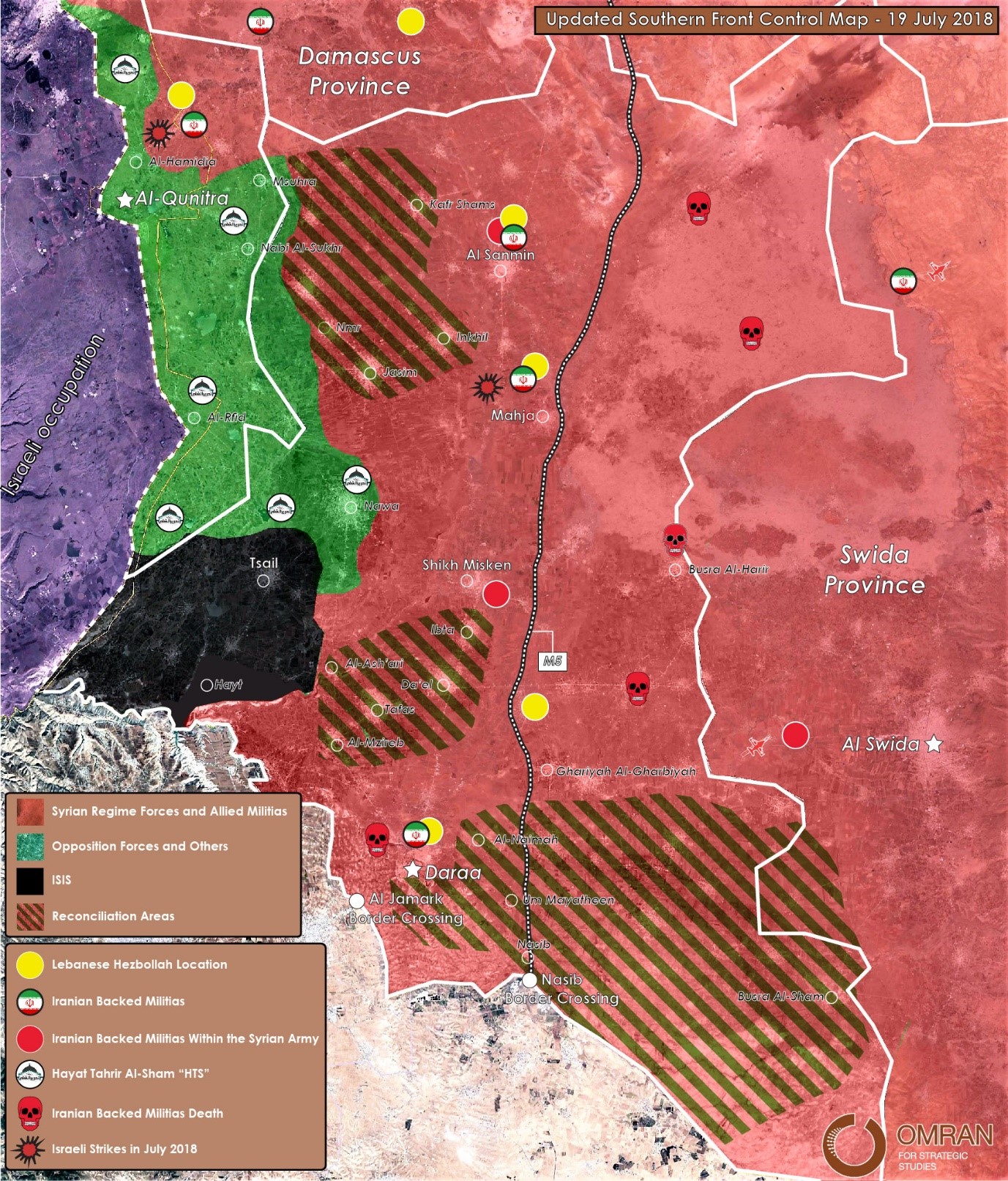
Map (1): Updated Southern Front Control Map - 19 July 2018
Iranian-backed forces suffered a number of casualties during the attack on Daraa, losing more than 50 top-level fighters – among these fighters were those from Hezbollah, as well as Khalil Takhti Nejad, a fighter for the IRGC. Nejad was deployed to Syria as a member of the Imam Sajjad IRGC Hormozgan Provincial Unit and commanded an operation from an unnamed base in a southwestern Syrian city of Daraa, approximately 32 km from Israel’s northern border.
Note: chart only indicates the number of dead among top Iranian-backed militias who participated directly in the recent Daraa battle; information obtained from monitoring pro-regime websites and official militia accounts.[4]
By the second week of July, Syrian regime and Iranian-backed militias announced that they had captured 520 km2 in Daraa province; 290 km2 from military operations and the remaining 230 km2 following a deal between Russia and the opposition factions. Syrian regime and Iranian-backed militias continued to advance along the Syrian-Jordanian border and reached the town of Khrab al-Shahm, facing no resistance from the opposition as most opposition forces had withdrawn from the borderline earlier.
Footage from Daraa battle of Iranian participation
The images below were taken from official media accounts of the participating militias and from pro-regime accounts.
Eastern Daraa Agreement and Western Daraa ongoing Negotiation
The situation in Daraa remains unclear. Four major events that are underway include:
- Green buses are waiting in pro-regime areas in Izra to transport a small amount of the opposition to Idlib as part of Friday’s 6th of July reconciliation agreement.
- Opposition commanders in the east and west are divided about what to do next. A commander([5]) in the east stated that opposition fighters would be responsible for the security situation in east Daraa for six months alongside Russian military police. At the same time, opposition forces in western Daraa rejected the agreement that took place in the east and announced they would hold their ground for now. A number of commanders escaped from Daraa to Jordan, including Bashar al-Zu'bi, Abu Omar Zaghloul, Raed Radi, Emad Abu Zureiq, Morhaf Al-Aboud, Anas Al-Zaeym, Ziad Al-Ghorani, Iyad Kaddour, Ziad Hariri Al-Bardan, and Abu Sidra Mashhour Canacry.
- Jordanian military commander Gen. Khaled al-Massa’id said reopening the Nasib border crossing would benefit both countries, in both security and economic aspects([6]).
- On 15 July, the first batch of civilians and fighters displaced from Daraa city arrived to Qalaat al-Madiq in Northern Hama. This batch consisted of 9 buses and 2 ambulances carrying at least 430 civilians and fighters.
About 20 buses are expected to depart with hundreds of civilians and fighters of Islamic factions with their families. There were about 1400 people expected to depart but the committees which are close to Russia are trying to persuade people to stay instead of evacuating to the north for the following reasons:
- Russians do not want Aleppo and Deir Ezzor experience to repeat itself, and allow Iranian backed forces to fill the gap in any displaced area.
- Russians tried to preserve the solid security situation in Daraa by transforming some of the opposition forces into local security forces responsible of protecting their own cities.
Note: In regards to Quneitra, there is no agreement until now and no initial negotiation between the Russian and any faction of the opposition forces. Russian negotiators want HTS to leave its post before starting any kind of negotiations.
The situation is being continually monitored in order to maintain an eye on what changes occur. The opposition’s divided actions will continue to leave it exposed to manipulation by outside forces. The Syrian regime will further its presence in the south by playing off the Israel-Russia-Iran trio; and Jordan will observe silently without exerting much effort in terms of actual fighting with or against any of the parties involved. With Russian forces gaining more ground in Syria whether at the behest of the Syrian regime or by making unilateral moves, it will be crucial – albeit difficult – to observe how Iran proceeds to protect itself and its assets in Syria.
([1]) 29 May 2018 – Telegraph - https://goo.gl/Z5jFUh
([2]) 8 July 2018 – Fares News - https://goo.gl/3KdLpU
([3]) 10 June 2018 – Daily Sabah - https://goo.gl/noyzPV
([4]) These number from monitoring Pro Regime and Iranian backed militias account, and also by special report from the Information Unit Ground Sources
([5]) 10 July 2018 – Skype Interview by the Information unit with a commander from the Southern Front
([6]) 16 July 2018 – Al Masder News - https://goo.gl/zyKA28

